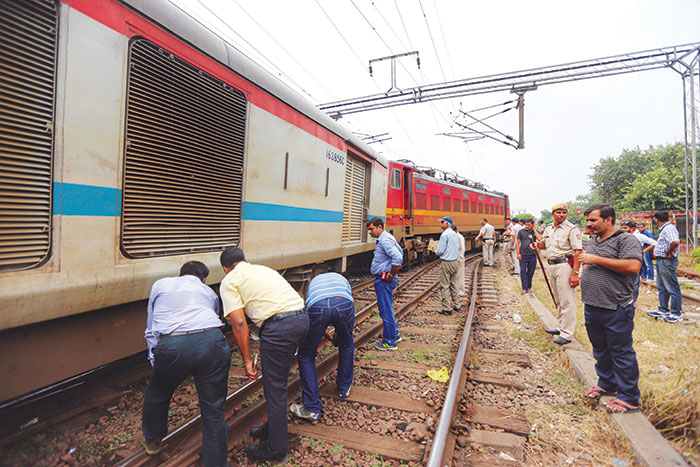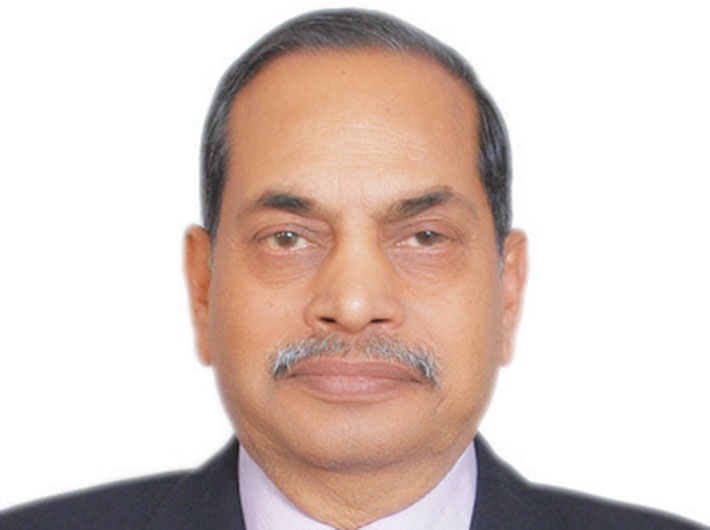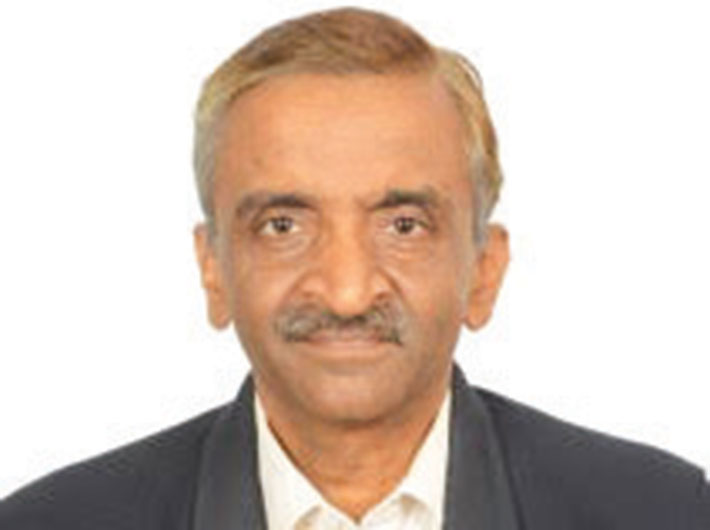A series of derailments underlines the urgent need to overhaul the top decision-making body which is yet to devise a comprehensive strategy to ensure passenger safety
The derailment of the Puri-Haridwar Utkal Express on August 19 at Khatauli in Uttar Pradesh which killed 23 people has raised serious questions on the functioning of the railway board.
A number of derailments in recent months indicate that there is something seriously wrong with the board which has failed to put pressure on the general managers (GMs) and the divisional railway managers (DRMs) to improve day-to-day operations, especially those related to safety.
The railway board which looks after policies as well as operates and regulates the railways has so far not taken any extraordinary measures on safety and saving lives.
READ: Sloppy planning
The railyway board that comprises six members - each one looking after a specific area like traffic, traction, personnel, finance etc - has no member to look after the issues of safety. The railways highups believe that no single member is required to be detailed for safety as it’s the collective responsibility of the board.
The track record of Indian railways during past three years has been pretty bad: over 300 passengers died in 200 derailments in three years. This includes 145 dead in derailment at Pukhrayan in Uttar Pradesh. Yet nothing changed in the railways including the seemingly poor safety standards. The railway board failed to adopt modern technology, boost LHB coach production and unveil a comprehensive safety strategy.
One of the key reasons for inaction on safety, as some top level sources in the ministry alleged, is the continuing tussel among the members of the railway board on the issue of blocks. (‘Block’ is a railway term for stopping train movement on a particular section, that is, a stretch of tracks for a period ranging from half an hour to a few hours to carry out maintenance and repair works.)
 Since blocks affect punctuality (trains are halted at the nearby station for a while) and erode the revenue as well, the traffic department often delays permission to the engineering staff to carry out maintenance work. But due to increasing load on the existing rail infrastructure, routine and emergency blocks are needed more often to make sure trains do not derail.
Since blocks affect punctuality (trains are halted at the nearby station for a while) and erode the revenue as well, the traffic department often delays permission to the engineering staff to carry out maintenance work. But due to increasing load on the existing rail infrastructure, routine and emergency blocks are needed more often to make sure trains do not derail.
Officials admitted, in private, that all was not well between the board member (engineering) and the member (traffic) over the issue of blocks.The board is also not making efforts to make GMs more accountable.
The Utkal Express derailment is the second biggest accident of the year, after the Jagdalpur–Bhubaneswar Hirakhand Express derailment in Vizianagaram on January 21 that left 41 persons dead.
After facing criticism from the media, the then railway minister Suresh Prabhu cracked the whip; he sent on leave the member (engineering), Aditya Kumar Mittal, and two other senior officials – the northern railway general manager (GM) and Delhi divisional railway manager (DRM). Mittal had to leave at a bitter note since he was due to retire just a week later.
It was perhaps for the first time when a secretary-level officer was asked to go on leave. (The two other officials returned to their job in September.)
Some believe Mittal was made scapegoat in the Utkal Express derailment case while the traffic wing did not even have to face the music from Prabhu.
Shiv Gopal Mishra, general secretary, All India railwaymen’s federation, which is considered the railways’ biggest employees union, told Governance Now that whenever an accident takes place, board members, GMs and other senior officials start efforts to save their skin and pass the buck.
He said the differences among the board members, GMs and DRMs on all issues including the blocks have persisted for many years.
Mishra said manifold increase in traffic has resulted in reduction of blocks since profitability is seen more important than safety and maintenance. “Operating officials including DRMs think that a maximum number of trains should run in their sections while engineering staff tries to get regular blocks which are not being given due attention,” he said.
In his May 24, 2017, letter to the railway minister, Mishra had flagged his concern over the derailments. “Railways is not getting enough rails as Steel authority of India (SAIL) does not have enough capacity to supply it,” he said.
Sunil Kumar former additional member (IT) and advisor, safety, railway board

"Safety is always given a lip service"
What kind of safety measures does the Indian Railways need?
Safety of railways is linked with operations and maintenance. Safety is a byproduct of assets, rules and regulations, which are the three pillars and they have to be in close coordination.
There have been two types of regimes across different railway networks globally – zero death and zero accident. Many countries have had the zero death regime because of a number of factors including better safety measures. But they failed in preventing accidents despite having best infrastructure. India has failed miserably in implementing both the regimes. However, the records are improving progressively. During 1960-61, there used to be around 300 collisions which have come down to four-five. Indian railways will have to pull up its sleeves for achieving the zero death regime.
Also, one needs to check how many times the railway minister convened safety meetings and interacted with the media on safety of railways, in the last three years. Earlier, railway ministers had made it mandatory to do field visits and examine activities at the grass root level. Unfortunately, for the past three years, the top level officials passed on this responsibility to second-rung officials, which is not a good sign for the railways and imperils the safety of travellers.
Are safety funds under the Rashtriya Rail Sanraksha Kosh enough to revamp the railways?
The Rashtriya Rail sanraksha kosh (RRSK) of '1 lakh crore should have been established at least five years back.
The railways say that its assets are getting flogged but on other hand it avoids injecting enough funds into safety related measures. Punctuality meetings are being convened by DRMs and GM on a daily basis but, unfortunately, same is not the case with safety. The meetings on safety happen only when any major accident occurs that too because of mounting pressure from the media.
Despite the regular reports of asset failure, breakage of rail and other irregularities, no concrete measures are being undertaken for safety,
What should be done for railways safety?
Despite the railways spending money on safety there is no significant output. The railway board needs an arbitrator who does not allow one-to-one conversation. The role of the arbitrator needs to be played either by the CRB or some other senior official. Safety is always given a lip service.
Foreign technologies have not helped the railways; home-grown technologies have. Had the foreign technologies been customised for Indian conditions, they might have proven good.
There should be more and rapid production of German LHB coaches. None of the passengers sustained injuries in two recent derailments – Kaifiyat express and Nagpur-Mumbai Duranto express – because of LHB coaches, which have more safety features.
The renewal of rail which should have happened at a certain level has not kept pace with the current requirements. The detection mechanism for rail defects is faulty. Besides, ultrasonic flaw detection is being done manually, not mechanically. In some sections the fracture detention work has been given to private contractors which raises suspicion on their ability. Luckily, introduction of new trains that used to be done as a populist measure has been stopped of late. No new train should be introduced for the next three years.
Examinations to recruit around 30,000 safety category staff and loco drivers have been conducted but there is undue delay in declaring the results. This has put more pressure on the existing locomotive pilots who are working overtime.
Gangmen used to be sturdy people who would even lift the rail as it’s purely a manual job. Now, youth having higher qualification are joining as gangmen which shows that they do not intend to do hard physical work. The real (gangmen) cadre is getting depleted. At the ground level, railways’ manpower has become weak and under-skilled.
What is your observation on the derailment near Khatauli?
In the Khatauli-Utkal derailment, the ground staff allegedly carried out maintenance without taking safety precautions. It shows that the indiscipline has risen.
Let us assume the traffic block was not given but did it justify not putting the red banner flags? In emergency, a gangman is authorised to put a red banner. Has the board woken up after a series of derailments, is the real question to be asked. The resignation of the CRB or the minister is not going to solve the problem.
The Utkal derailment is a case of gross neglect. The government, for the last three years, has been hyping on the futuric plans but, it seems, it’s least bothered about the present. There is little focus on the day-to-day operations and more on the vision. The railways is a dynamic and robust organisation where every moment hundreds of lives are at risk if safety is compromised.
Most of the board members believe in saving their faces during a crisis. if this continues, the Railways will remain as vulnerable as it was always.
Two recent derailments – of the Kaifiyat Express at Auraiya in UP and the Nagpur-Mumbai CST at Vasind near Mumbai in August – further added to the woes of railways. Luckily, nobody suffered injury in these accidents. A week later, three trains – two passenger and a goods train – derailed on September 7, bringing further embarrassment to the board.
However, after the derailment of the Kaifiyat Express, heads started rolling; the chairman of the railway board, Ashok Kumar Mital, an officer of the rank of principal secretary, was asked to step down. In the same evening, Prabhu offered his resignation to prime minister Narendra Modi.
Ten days later, Piyush Goyal, who was minister of state for power, coal, new and renewable energy and mines, was named the new railway minister while Prabhu was given charge of commerce.
Officials at the helm said the missing balance between efforts to increase revenue and ensuring punctuality of the services has resulted in poor focus on safety. “The situation reached a point where the board members and general managers are more focused on executing the fancy projects like the high-speed bullet train rather than making railways safer,” a ministry official said on condition of anonymity.
The national transport development policy committee (NTDPC) report of 2014 has pointed out that the railway board has the unique distinction of being the rule maker, operator and the regulator but compliance of safety standards set by the railways for themselves are often thrown out of window for operational exigencies.
The high level safety review committee (HLSRC) set up by the centre in 2012, headed by former Atomic energy commission chief Anil Kakodkar, points out that introduction of new trains has exerted pressure on the existing infrastructure. It has strained the infrastructure way beyond its limits and all the safety margins have been eaten up, pushing the railways to a regime of ad-hocism in infrastructure maintenance.
The Kakodkar committee also made a suggestion to the railways to set up a Railway research and development council (RRDC) led by an eminent scientist and with chairman and technical members of the railway board as its members.
The 2012 report of the expert group for modernisation of Indian Railways suggested that the railway board be reorganised to reflect chairman as chief executive officer. There should be members for safety, business development/commercial, technology/ICT, freight, passenger services, infrastructure, finance and human resource.
M Raghaviah, general secretary, National federation of Indian railwaymen, another union of the railway staff, said that the railway board was not taking quick decisions on several issues. For example, he said, the board was yet to fill around 1.60 lakh vacancies in safety related categories because of which the existing staff was overburdened.
“There should be more coordination among the traffic, engineering and other departments for safety and higher revenue for the railways,” he said.
Another area where the board has been unsuccessful is lack of research and development for adoption of cutting-edge technology for safety.
Vivek Sahai former chairman, railway board

"Safety taken for granted"
Recent derailments indicate poor coordination between the engineering and traffic departments of the board. Do you think the board is entangled in infighting?
Infighting between the railway board members cannot be ruled out. Generally, infighting is not department-oriented but personality-oriented. But if it is happening on a department level then it is a matter of concern. The dissent between the board members may happen on a host of issues but the problem regarding permissions of blocks may not reach to that level. It has to be resolved at the zonal level by GMs and DRMs.
When a track fracture is detected through ultrasound devices and operations continue, officials usually take a call to repair the fracture within a few hours or the same day. In this case, DRM and GM have to coordinate with different departments such as signalling and telecom, engineering, traffic among others. When there are more blocks, revenue and punctuality are bound to get affected. So a balance has to be maintained.
DRM, GM and CRB should coordinate with operating, electrical, commercial, civil engineering and mechanical departments at their level. The problem of blocks has to be resolved at the DRM level. DRM should ensure every department works in tandem. If the matter is not resolved at the DRM level, it should be looked after by the GM and then the railway board.
How important is the role of the chief safety officer?
It should be examined how the CSO is working and what inspections are being carried out and whether safety counselling sessions are conducted to ensure people do not commit mistakes. That has been given a go by. Safety has been taken for granted.
What exactly went wrong in the Khatauli derailment?
If there was some problem and the track inspector sought permission for a block from the operating department which was denied then the track should not have been cut on the Khatauli section.
Track maintenance staff cannot carry out repair work if the permission for block is denied by the traffic wing. Despite this, if block is considered inevitable in case of an emergency, then the inspector has the power to declare that this particular track is unsafe. In that case, no train can pass on that track. Inspectors have such powers to check the track and issue a memo to carry out blocks.
It is absolutely correct that the gangmen and other ground staff did not display the red flag 1,200 metres away from the site at the both ends where the track was cut for repair. It is a matter of grave concern. Here comes the role of safety counselling to be done by the CSO. There are safety counsellors in every division and they barely pay attention to counsel gangmen and other civil engineering staff.
It should be probed how many times the safety counsellor of Khatauli section conducted counselling sessions of gangmen and other civil engineering personnel two months before the derailment. DRMs and GMs have to make a field visit and check whether inspections are being done at the ground level.
It should also be checked when did the CSO of northern railway take the safety inspection and what was the outcome. CSO should be upgraded to higher administrative grade for better monitoring of safety and giving muscle to the department.
The NTDPC report stated that a comparison of the technologies employed in the Indian railways and other systems the world over shows that we woefully lags behind competitors in technology. It says there is a gap of a few decades between modern technologies in the developed railway systems and the Indian system.
The railways’ sole R&D organisation – Research designs and standards organisation (RDSO) — functions as technical advisor to the railway board, zonal railways and production units and develops new and improved designs. If national transport development policy committee’s report is taken into consideration, laboratories of RDSO have achieved limited purpose and these are no longer state-of-the-art.
It also says despite existing laboratories and strategic alliances with the IITs at Kanpur, Roorkee, New Delhi and Chennai and the Defence research and development organisation (DRDO), Indian Railways is mostly dependent on imported technology. RDSO’s role is mainly restricted to help the railways adopt imported technology.
“RDSO is hamstrung by the government procedures in procurement of research and testing equipment,” it stated.
Indian Railways Vision 2020 document noted that IR should establish the world’s most advanced research and development capabilities for transfer of indigenisation of technology and breakthrough innovations. It laid emphasis on revamping RDSO and its integration with the core of railways operations.
Soon after taking charge, Goyal found that unmanned level crossings and defects in tracks are two major causes behind railway accidents. Goyal directed officials to eliminate all ULCs within one year as against three years timeline set by his predecessor. The railways will need more such quick decisions for safety.
vishwas@governancenow.com
(The story appears in the October 15, 2017 issue)

